Metaverse Tournaments: The Future of Competitive Gaming Online
Updated On: November 13, 2025 by Aaron Connolly
What Are Metaverse Tournaments?
Metaverse tournaments bring competitive gaming into virtual 3D worlds. Players and spectators use avatars to interact in these digital spaces.
These events blend classic esports competition with immersive VR features. You get virtual stadiums, avatar customisation, and real-time socialising.
Key Differences from Traditional Gaming Tournaments
Traditional gaming tournaments put players at screens while spectators watch via streams or in-person events. Metaverse tournaments flip that script.
In the metaverse, spectators show up as avatars and roam virtual stadiums. You can sit with friends, wander the field, or chat with strangers during the action.
These tournaments rely on VR and AR tech for full immersion. Players don’t just control characters—they step right into the game world.
Some standout tech features:
- Blockchain for secure payments and transactions
- AI-driven gameplay enhancements
- Digital merchandise and asset ownership
- Cross-platform play on many devices
Organisers find new ways to make money, too. They sell virtual land, digital merch, and exclusive avatar upgrades right inside the metaverse.
Examples of Popular Platforms
Several platforms now host metaverse tournaments, and each one adds something fresh to the mix.
Fortnite stands out with its wild virtual concerts and massive tournaments. Millions of players can join these events at once.
Roblox lets communities build their own arenas and host custom tournaments. Players get creative control over their virtual worlds.
Horizon Worlds by Meta focuses on social gaming tournaments. You can compete in mini-games while chatting through your VR headset.
Decentraland takes a blockchain-first approach. Tournaments there pay out crypto prizes and NFT rewards, and players can own virtual land.
Most of these platforms support both casual and pro-level competitions. Some events are free, others ask for virtual currency or real cash to join.
Notable Milestones and Growth
The metaverse tournament scene has exploded in the past few years.
Back in 2023, the first major VR-only esports tournament drew over 100,000 participants at once. That proved these platforms can scale up fast.
Prize pools used to be under £10,000, but now we see events offering over £500,000. That’s a huge leap.
Spectator engagement has climbed too. When fans can interact in virtual spaces, average viewing time jumps by 60% compared to just watching streams.
Big esports names like Team Liquid and Cloud9 now run metaverse teams. That shows the industry believes in this format.
Hybrid tournaments picked up speed in 2024. These events blend classic esports with metaverse viewing, so fans choose how they want to join.
Industry experts think metaverse tournament viewership will top traditional esports by 2027. Better VR headsets and faster internet are helping push things forward.
How Metaverse Tournaments Work
Metaverse tournaments mix classic esports formats with immersive virtual worlds. Players compete using VR tech, digital avatars, and blockchain prizes.
Tournament Formats and Structures
Most metaverse tournaments stick to familiar esports setups but add virtual twists. Single elimination brackets keep things quick, while round-robin leagues last for weeks.
Battle royale tournaments drop 100 players into shrinking worlds. Team formats pit squads against each other for objectives. Hybrid tournaments sometimes mix standard matches with metaverse exploration challenges.
Organisers track progress with live leaderboards. The Metaverse Gaming League (MGL) hosts monthly events, and prize pools can range from £500 for amateurs to £50,000 for the pros.
Some unique format features:
- Virtual venues that change over time
- 3D spectator zones for fans as avatars
- Cross-platform play between different metaverse worlds
- NFT rewards and digital collectables
Entry Requirements and Accessibility
Entry barriers really depend on the tournament. Free events just need a basic VR headset or a gaming PC. Premium tournaments might charge £25-£100 but offer bigger prizes.
Most platforms ask for account verification via blockchain wallets. Players need a reliable internet connection—50 Mbps is usually enough.
You’ll need:
- A VR headset (Meta Quest 2 starts at £300)
- Gaming PC (at least an RTX 3060)
- Fast internet
- Blockchain wallet for prizes
Skill levels range from beginner to pro. Tournaments often have tiers for different ranks. Accessibility features like voice commands and custom controls help more people join in.
Some tournaments restrict entry by region, mostly because of local laws. European players usually get wider access.
Match Progression and Elimination Systems
Metaverse tournaments use classic bracket systems but add virtual twists. Swiss system tournaments let everyone play several matches, even after a loss. Double elimination gives you a second shot if you lose once.
How matches play out:
- Players spawn in as their avatars in virtual arenas
- Spectators roam freely in 3D to watch
- AI referees keep an eye on gameplay and enforce rules
- Blockchain records match results instantly
Elimination tracking happens through smart contracts that update in real time. Players can see their progress on interactive 3D tournament trees. Tiebreakers use stats like kill/death ratios or head-to-head results.
Winners get paid automatically in cryptocurrency. NFT trophies show up on their virtual profiles. AI-driven anti-cheat systems scan for suspicious behaviour during every match.
Some tournaments handle up to 1,000 players at once. Scheduling tools help manage time zones, so matches can run around the clock during big events.
Cutting-Edge Technologies Powering Metaverse Tournaments
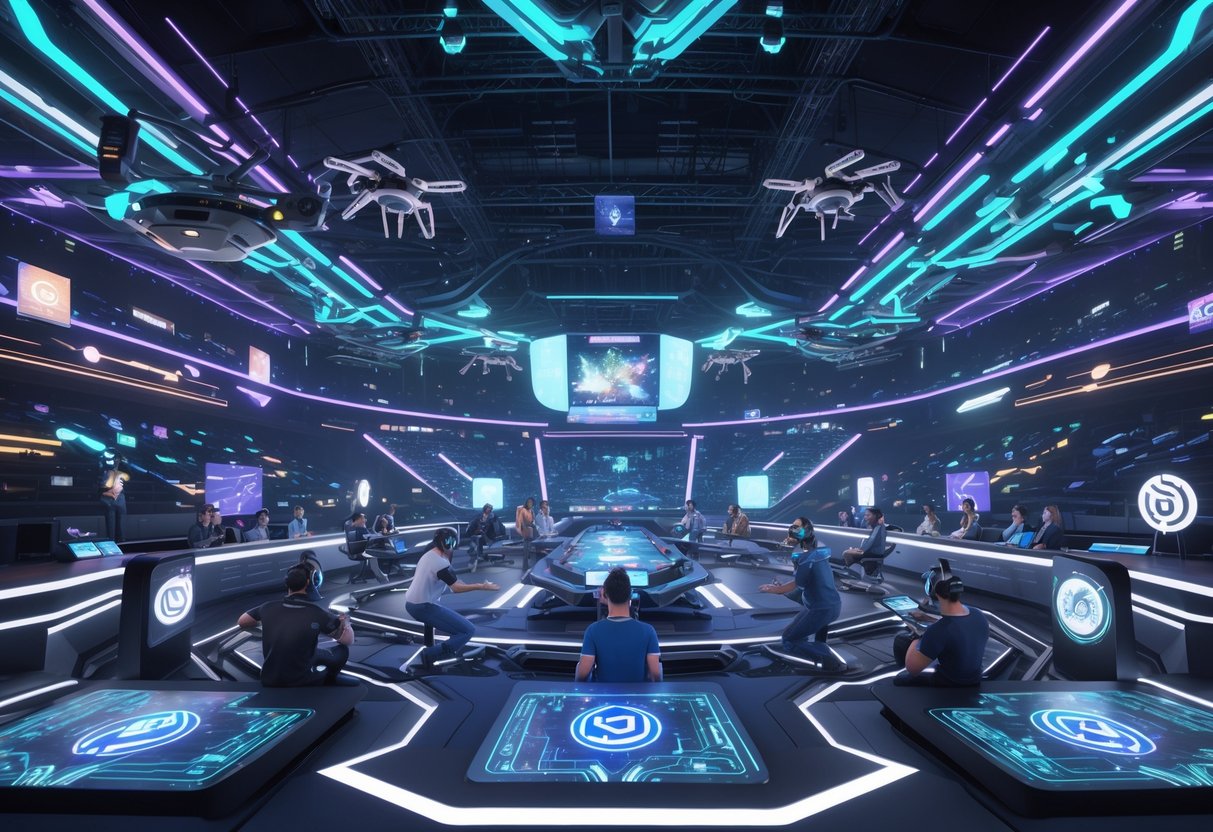
Three core technologies make metaverse tournaments so immersive. Virtual reality, augmented reality, and artificial intelligence all play their part.
These tools change how we compete, watch, and connect in digital tournaments. Traditional esports just can’t keep up with this level of immersion.
Virtual Reality Integration
VR headsets like the Meta Quest 3 and PlayStation VR2 drop players right into tournament arenas. Instead of staring at a screen, you’re standing in the game.
Popular VR tournament games include Beat Saber, Echo VR, and Pavlov VR. You need quick hands and good spatial awareness—old-school controllers just don’t cut it.
The Metaverse Gaming League (MGL) connects players across different VR headsets. Everyone competes in the same virtual space.
Spectators get a big upgrade, too. You can “attend” tournaments virtually, pick your own camera angles, and even see matches from a player’s view. That kind of engagement just doesn’t happen in regular esports.
Heads up: High-end VR gear can cost anywhere from £300 to £1,500, so it’s not cheap to get started.
The Role of Augmented Reality
AR overlays add digital elements to the real world. Players see virtual objects through phone cameras or AR glasses like the Microsoft HoloLens.
Pokémon GO tournaments are a great example. Players walk around real places, catching virtual creatures and competing at the same time.
Organisers use AR to spice up live events. They can show player stats or game info floating above the stage.
Blockchain tech often works with AR to prove digital asset ownership. Players can show off rare NFT items or custom avatars in their AR streams.
If you’re curious, try AR apps like Harry Potter: Wizards Unite or Minecraft Earth to get a feel for it before jumping into AR tournaments.
Artificial Intelligence Applications
AI changes the game in metaverse tournaments. Smart matchmaking pairs players by skill, style, and even where they live.
AI-powered NPCs make matches more interesting. These bots adapt to your strategies and keep things challenging.
AI coaching systems break down your performance in real time. They spot weak spots and suggest ways to improve between games.
Tournament anti-cheat systems lean heavily on AI. They catch odd behaviour, impossible reaction times, and fishy gameplay right away.
Cloud computing does the heavy lifting for all this AI. That keeps tournaments running smoothly, even when hundreds of players join from all over.
Customisable Avatars and Player Identity
Avatars in metaverse tournaments act as digital extensions of each player. These unique identities shape social interactions and competitive dynamics.
Custom avatars influence everything from team branding to psychological advantages during tense matches.
Avatar Creation and Personalisation
Building your avatar is about mixing personal style with practical needs. Most metaverse platforms give you loads of customisation tools for faces, clothes, accessories, and animations.
Basic options usually include:
- Face shape and skin colour
- Hair styles and colours
- Clothing or armour choices
- Gestures and emotes
Some platforms use AI to turn photos into lifelike avatars. Ready Player Me leads the way, letting you use the same avatar across tons of games and VR apps.
It’s smart to find a balance between standing out and staying focused. Flashy avatars can distract you, but boring ones make you forgettable.
Tip: Start with a preset and tweak it as you go. No need to build from scratch unless you really want to.
Organisers sometimes hand out exclusive avatar items as prizes. These rare accessories become status symbols in the community.
Impact on Social Presence and Competition
Your avatar shapes how teammates and rivals see you. Studies say a unique avatar gives you a stronger social presence, which helps with team communication.
Some psychological perks:
- More confidence from self-expression
- Better team bonding and recognition
- An intimidation edge over opponents
- Easier for fans and sponsors to remember you
Players often get attached to their avatars, almost like digital alter egos. That connection can boost performance by making you care more about the outcome.
Heads up: Some tournaments limit avatar changes to keep things fair and prevent sneaky advantages.
Teams often coordinate their avatar themes. Matching colours or accessories help build identity while letting everyone keep their own style.
Fans love it when players have memorable avatars. It’s easier to follow favourites during streams, and that boosts engagement.
Branding and Player Customisation
Professional esports athletes turn their avatars into branding tools, mixing in sponsor logos, team colours, and even personal signatures to shape their digital image. They open up extra revenue streams this way, selling branded merchandise and avatar items directly to fans.
Common branding elements:
- Team jersey designs
- Sponsor logo placement
- Personal catchphrases or symbols
- Signature colour combinations
NFTs let players actually own unique avatar items that have real-world value. Limited-edition tournament gear sometimes goes up in value, so competitive players get investment opportunities alongside style.
Blockchain tech makes sure you can transfer your avatar ownership between platforms. Your custom tournament identity comes with you, keeping your brand consistent wherever you play.
Teams now bundle avatar customisation into sponsorship deals. Players get exclusive items that both promote brand partners and make their avatars stand out.
Next step: When you design your tournament avatar, think ahead about branding. Pick base designs that work with different sponsor requirements—you never know who might come knocking.
Non-Fungible Tokens and Digital Ownership
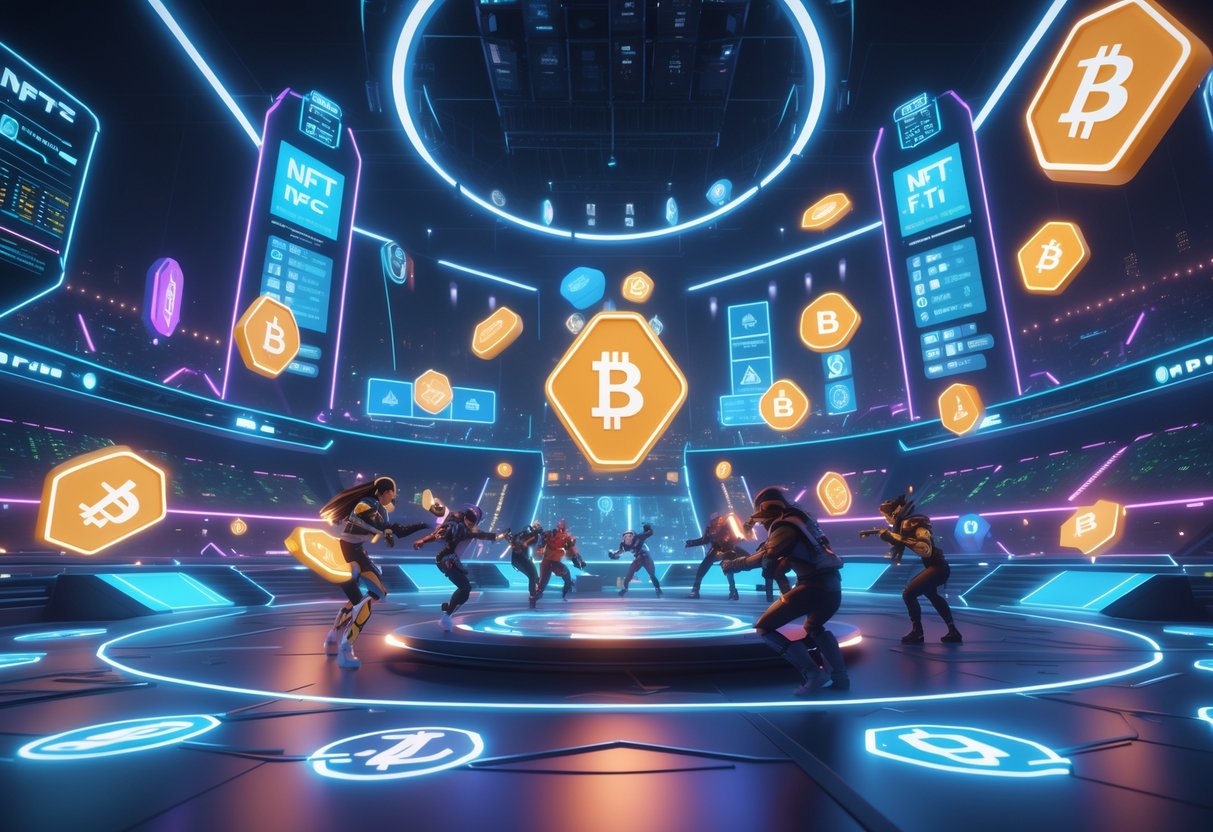
NFTs create unique digital ownership records, changing how players collect items, earn prizes, and show off achievements in metaverse tournaments. These blockchain certificates put true ownership in players’ hands, letting them trade, sell, or display assets across multiple virtual worlds.
How NFTs Are Used in Tournaments
Tournament organisers mint exclusive digital assets as NFTs for participants to earn or buy. These tokens prove participation, achievement, or membership in specific competitions.
Player identification cards are one example. Each competitor gets a unique NFT badge with their tournament history, team affiliations, and performance stats.
Access passes decide who gets into exclusive tournament areas. VIP NFTs might open up premium viewing spots, backstage access, or special chat channels during live events.
Team merchandise shows up as NFT wearables for avatars. Players wear digital jerseys, logos, or sponsor brands, showing off their allegiances wherever they go in the metaverse.
Tournaments also hand out limited edition NFTs for big moments. Championship matches, record-breaking plays, or anniversaries get unique collectibles that capture the memory forever.
NFTs as Prizes and Incentives
Prize pools now often include NFT rewards alongside crypto payouts. These digital assets sometimes hold more long-term value than regular tournament winnings.
Winner trophies exist as NFTs that players display on their profiles. Champions get unique digital awards to show off their victories across different platforms and games.
Performance rewards highlight special achievements. Best comeback, highest elimination count, or most creative play might earn a special NFT to mark the moment.
Seasonal rewards keep players coming back. Compete in several tournaments in a season and you might collect badge sets or evolving NFTs that upgrade as you perform.
Sponsor prizes blur the line between real and virtual. Gaming hardware brands, energy drinks, or streaming platforms offer branded NFTs—sometimes with discount codes or exclusive product access.
Tournament organisers like NFT prizes because they cost less than cash but stick around, keeping the event in fans’ minds long after it’s over.
Collectibles and Digital Merchandise
Tournament NFTs open up new revenue streams through collectible marketplaces, where fans buy and sell rare digital items from their favourite competitions.
Match highlights can become tradeable video NFTs. Spectacular plays or clutch moments get minted as collectible clips for fans to own and show off.
Player cards work like old-school trading cards. Stats, career highlights, and signature moves appear on NFTs that can rise in value as players succeed.
Stadium assets let fans own a piece of iconic tournament venues. Seats, banners, or even bits of architecture from legendary matches turn into collectible NFTs.
| NFT Type | Typical Value Range | Trading Activity |
|---|---|---|
| Participation Badges | £5-£25 | Low |
| Championship Trophies | £100-£500 | Medium |
| Historic Moments | £50-£1,000+ | High |
Limited edition drops create buzz around big tournaments. Maybe only 100 championship NFTs exist, so demand and prices on the secondary market shoot up.
We’ve noticed that the most successful tournament NFTs blend eye-catching visuals with real utility—early access to future events or exclusive community perks, for example.
Major Players and Leagues
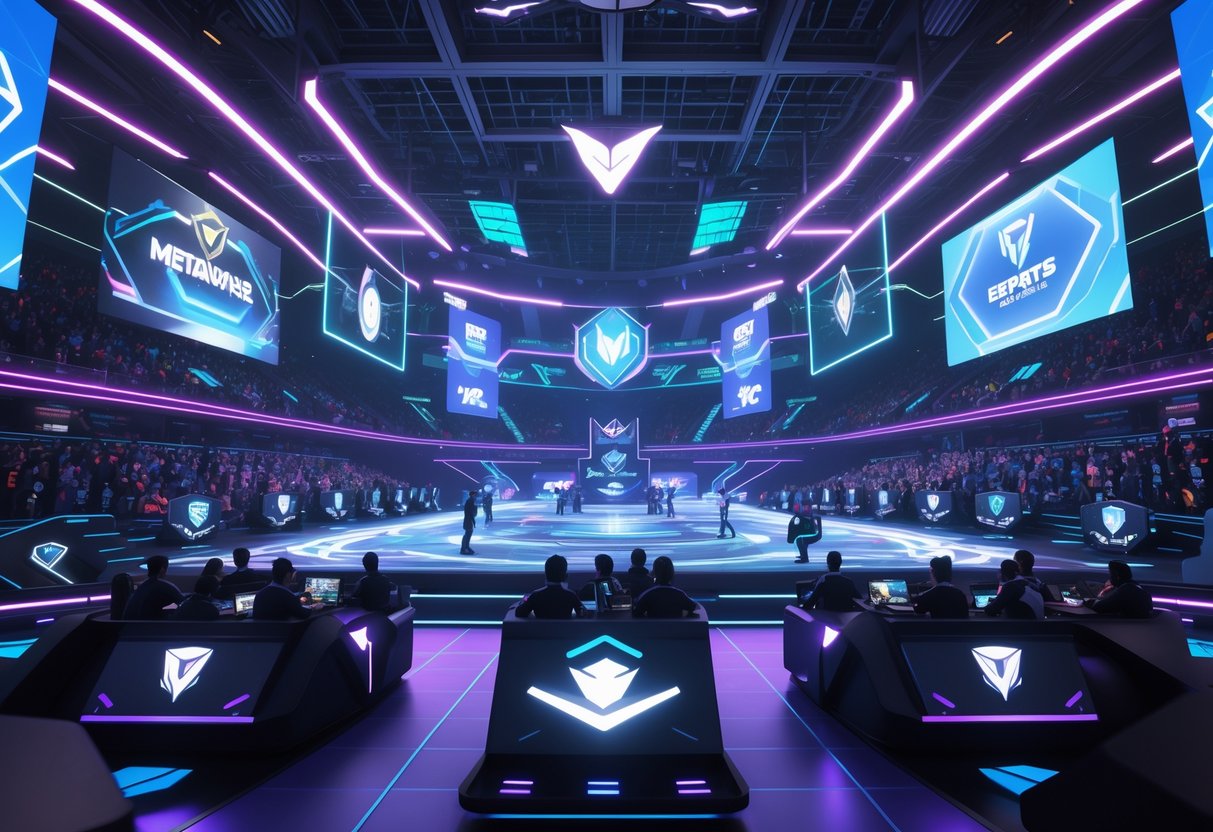
Established organisations and new platforms now lead the metaverse tournament scene. The Metaverse Gaming League dominates, while traditional esports groups move into these virtual spaces.
Overview of Metaverse Gaming League (MGL)
The Metaverse Gaming League runs the biggest tournament system in VR gaming. MGL holds weekly competitions across genres like boxing, football, martial arts, and basketball.
Their boxing division puts on high-profile matches—like the recent final between Keith “KLegendairy” Simpson and Ray “Knockout” Tyson. These matches stream live on Esports TV, reaching global audiences thanks to solid broadcasting deals.
MGL splits into several divisions:
• VR Boxing Championships – Weekly tournaments that lead to title fights
• Soccer League – Team-based competitions with defending champs
• Fighting Circuit – Individual martial arts battles
• VR Basketball – Including slam dunk contests and special events
The league runs year-round with a steady schedule. Winners take home prizes and earn rankings in their divisions.
Other Leading Esports Organisations
Traditional esports companies are jumping into metaverse tournaments. The International Metaverse League runs smaller events, starting with prize pools around £400 per tournament.
International Metaverse Football Federation (IMFF) oversees the Metaverse Football League (MFL), managing leagues and divisions much like real-world football.
These groups bring their sponsorship networks and broadcast know-how to virtual tournaments. They often team up with global brands to fund prizes and player rewards.
A lot of traditional esports organisations see metaverse tournaments as a big growth area. They’re investing in VR tech and recruiting players who already know the ropes in virtual reality.
Emerging Platforms and Start-Ups
New platforms want to create multi-sensory tournament experiences for players. These start-ups focus on the financial side too, letting players run virtual teams and manage budgets.
Gaming ecosystems now support real-time global participation. These platforms appeal to casual players who want the tournament feel without going pro.
Plenty of emerging companies specialise in certain game genres or regions. They’re building communities first, then planning to expand into bigger tournaments.
Warning: Some of these newer platforms don’t always guarantee prize pools or have proper oversight.
Start-ups keep experimenting with tournament formats and rewards. Their innovations push established leagues to keep improving.
Virtual Events and Social Interaction
Metaverse tournaments spark vibrant communities, letting players and fans connect through immersive experiences. These events turn gaming into shared spaces, where spectators jump in and teams work together in ways that old-school tournaments just couldn’t allow.
Online Gatherings and Community Engagement
Virtual events in the metaverse bring gaming communities closer than ever. Players meet up in digital lobbies before matches, chat, swap strategies, and make friends that last beyond tournament day.
Organisers set up dedicated social spaces inside virtual venues. These spots act as digital hangouts between matches. Some events toss in mini-games or activities to keep people entertained during breaks.
Community features let attendees customise avatars and show off their style. Players often coordinate team colours or themed outfits, which helps teams bond and makes the experience more memorable.
Real-time communication tools take the social side up a notch. Voice chat, text, and emoji reactions make interactions feel natural. Many tournaments now run community polls or live Q&A sessions with players.
Spectator Experience in Virtual Venues
Watching tournaments in the metaverse beats traditional streaming in a lot of ways. Spectators pick their own viewing angles and move around virtual arenas. You can follow your favourite player up close or zoom out for a big-picture view.
Virtual venues don’t have capacity limits. Fans from all over the world show up for the same event at the same time. This global reach creates diverse communities and brings in new perspectives.
Interactive spectator features turn viewers into active participants. Fans predict match outcomes, vote for player awards, and join in crowd reactions. Some events even let spectators influence game elements through group votes.
Social viewing parties pop up naturally. Friend groups set up private viewing areas inside the main venue. They chat about the matches in real time, without bothering other fans.
Collaborative Features and Team Play
Team coordination gets a boost in metaverse tournaments. Players share virtual practice spaces to rehearse strategies together. These environments match tournament conditions almost perfectly.
Strategy planning tools inside virtual venues help teams get ready. Coaches sketch plays on interactive whiteboards. Teams watch match footage together in shared viewing rooms.
Communication during matches feels more natural with spatial audio. Team members hear each other based on position, just like in real life. That makes coordination smoother and cuts down on confusion.
Cross-platform play brings together PC, console, and mobile players in one space. This inclusivity expands who can join tournaments and adds more variety to the competition.
Monetisation and Economic Impact
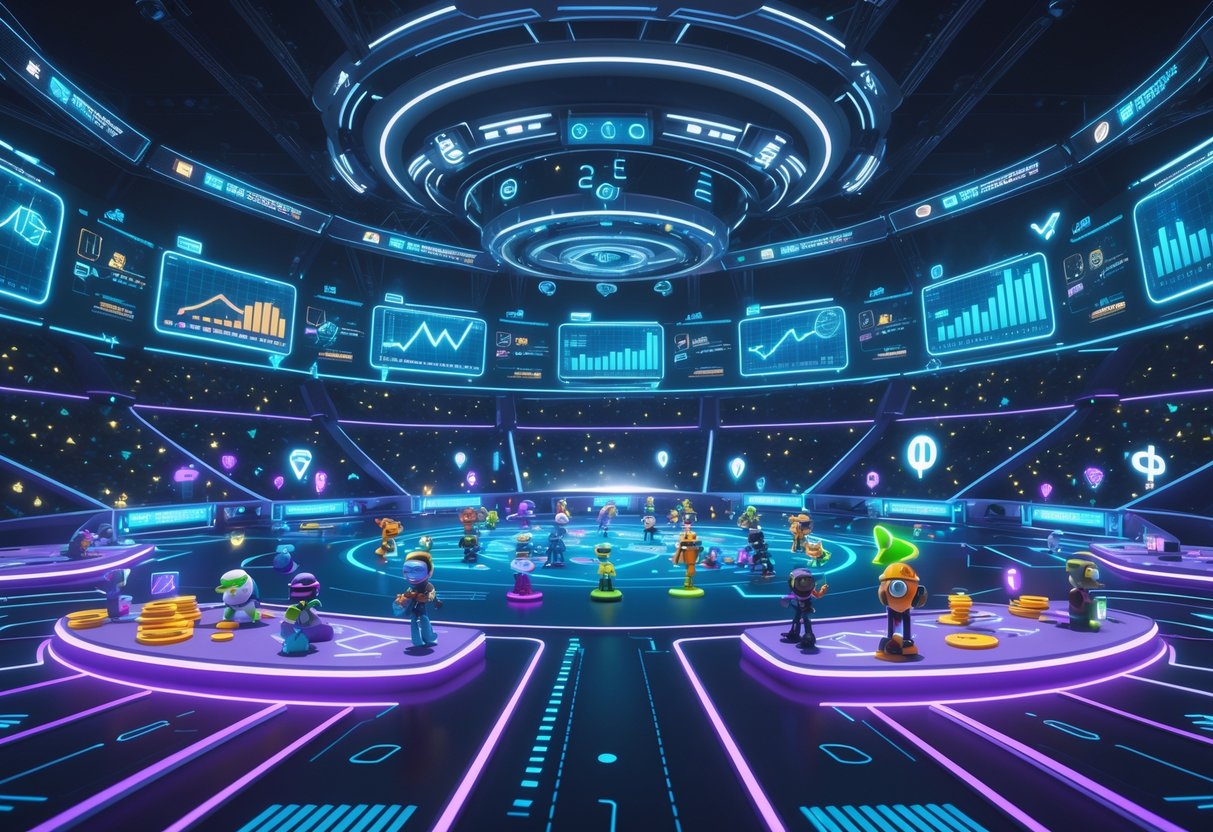
Metaverse tournaments unlock revenue streams that traditional esports just can’t match. Virtual events blend old-school sponsorship models with blockchain economies and digital asset ownership.
Sponsorships and Brand Partnerships
Virtual tournaments give brands advertising options that go way beyond banners. Companies can build immersive brand experiences right inside the metaverse.
Sponsors might set up virtual showrooms, letting viewers browse products during breaks. Nike could sell digital trainers as NFTs. Energy drink brands might sponsor virtual lounges where players hang out before matches.
Brand integration possibilities include:
- Custom virtual venues with company names
- Branded NFT prizes for winners
- Interactive product demos during streams
- Virtual meet-and-greets with pro gamers
Metaverse events pull in viewers from dozens of countries, making sponsorships more valuable. No one needs to travel, but the reach is global.
James Connolly, a gaming expert, puts it this way: “Metaverse sponsorships allow brands to connect with audiences in ways that feel natural rather than intrusive.”
In-Game Purchases and Tokens
Organisers make money through digital economies built around their tournaments. Players and viewers spend real cash on virtual items to enhance their experience.
Popular monetisation options include:
- Tournament passes for exclusive content
- Cosmetic items like special avatars or victory dances
- Virtual merchandise sold as NFTs
- Betting tokens for prediction games
NFTs play a huge role. Winners might get digital trophies to trade or display. Rare in-game items from famous matches can fetch hundreds of pounds from collectors.
Some tournaments launch their own crypto tokens. Viewers earn tokens by watching matches, then use them for exclusive stuff or even cash out.
Warning: Gaming token values can swing wildly and are unpredictable.
Opportunities for Players and Developers
Professional gamers in metaverse tournaments make money from more than just prize pools. Top players sell branded virtual items, host paid training sessions, and put out exclusive content for subscribers.
Player revenue opportunities:
- Prize winnings from tournament victories
- Streaming revenue during practice and matches
- NFT sales of memorable gaming moments
- Virtual coaching sessions in private metaverse spaces
Game developers see a boost in player engagement during tournaments. Popular tournament games attract new players and drive up in-game purchases.
Developers sometimes join forces with tournament organisers to create special game modes or exclusive content. These collaborations can bring in more revenue than old-school advertising.
The metaverse lets smaller developers host global tournaments without spending a fortune on infrastructure. Even a two-person indie studio can organise international competitions using existing virtual platforms.
When a tournament does well in the metaverse, the game often stays popular and keeps making money.
Challenges and Ethical Considerations
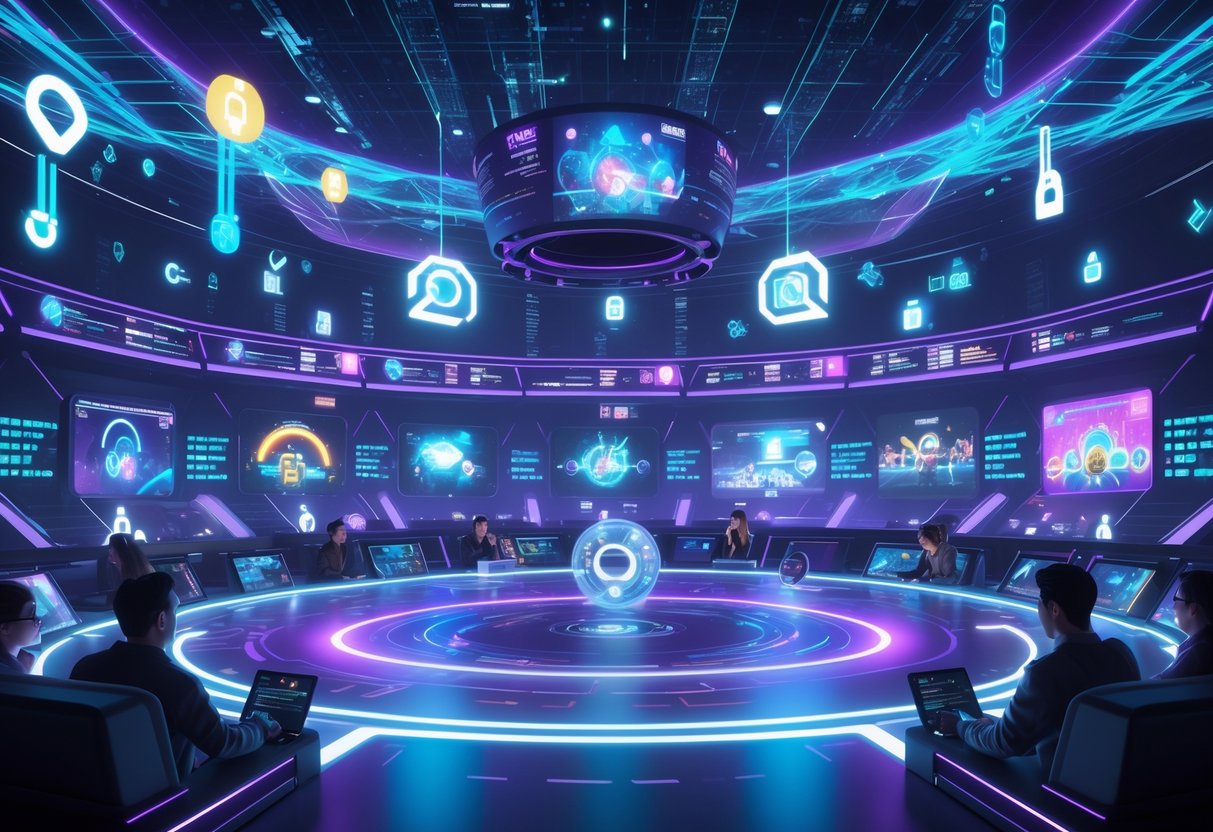
Metaverse tournaments run into some tough issues that could hurt players and shake trust in competitive gaming. These problems touch on fair play, player safety, and how we govern these virtual competitions.
Cheating and Security Concerns
Metaverse tournaments give cheaters new tricks that traditional esports never had to deal with. AI-powered tools now scan virtual environments in real time and hand out unfair advantages.
Common cheating methods include:
- Avatar manipulation to change hitboxes or movement speed
- Environmental hacking to see through walls or objects
- AI assistants that predict opponent moves
- Data injection attacks during live matches
Hackers target tournament organisers’ servers, going after sensitive player data, financial info, and match footage.
Virtual environments make it hard to catch cheaters compared to regular PC games. Anti-cheat software struggles to keep up with all the complex player interactions in 3D spaces.
Warning: Many metaverse platforms skip proper security audits, so tournaments stay wide open to attacks.
Tournament operators need strong verification systems. Blockchain tech can track player actions and keep permanent match records.
We suggest using multi-factor authentication and running regular security checks. Players should double-check platforms before handing over personal info.
Data Privacy and Digital Well-being
Metaverse platforms scoop up huge amounts of personal data during tournaments. This includes biometric information, movement patterns, voice recordings, and social interactions.
Players usually don’t realise how much data companies collect. VR headsets track eye movements, head position, and even stress levels through sensors.
Key privacy risks:
- Unauthorised data sharing with sponsors
- Permanent storage of private conversations
- Tracking of player behaviour outside tournaments
- Sale of personal information to third parties
Digital well-being gets tricky in these immersive spaces. Long tournament sessions can bring on motion sickness, eye strain, and social isolation.
Mental health concerns grow when players spend too much time in virtual worlds. Some folks struggle to separate their digital identity from real life.
Quick win: Set time limits for practice and take breaks every 30 minutes.
Tournament organisers should roll out clear data protection policies. Players deserve to know what info platforms collect and how they use it.
We need better consent tools that explain data use in plain language. Players should be able to delete their info and opt out of data collection.
Regulation and Governance Issues
Metaverse tournaments operate in a legal grey zone. No one’s really set the rules or created oversight bodies, so things get confusing around player rights, prize distribution, and settling disputes.
Current esports regulations don’t really cover competitions in virtual worlds. Traditional sports authorities don’t have much experience with metaverse tech or digital assets.
Major governance challenges:
- Cross-border jurisdiction conflicts
- Unclear intellectual property rights
- Prize payment disputes
- Age verification difficulties
- Content moderation standards
Tournament organisers often make up their own rules without outside input. This leads to inconsistent standards and sometimes unfair treatment.
Prize pools paid in virtual currencies bring up tricky tax and legal issues. Players don’t always know what’s expected of them when they win digital assets.
Different countries handle metaverse regulation in clashing ways, making international tournaments a headache.
We need regulatory frameworks built for virtual competitions. These should focus on player protection, fair play, and technical standards.
Industry self-regulation through player associations could set minimum standards. Transparent governance would help build trust among players.
Tournament operators should talk to legal experts and set clear terms and conditions. Players need simple ways to resolve disputes when things go wrong.
Accessibility, Inclusivity, and Diversity

Metaverse tournaments can smash through physical and language barriers that used to limit gaming competition. These virtual spaces offer customisable experiences and real-time communication tools, making competitive gaming open to players no matter their abilities or location.
Removing Physical and Social Barriers
The metaverse changes how we think about joining tournaments by tossing out old physical limits. Players with mobility issues can compete equally using custom avatars and adaptive controls. Eye-tracking tech lets competitors move through virtual worlds without the usual input devices.
Key accessibility features include:
- Haptic feedback for players with visual impairments
- Audio cues and spatial sound design
- Adjustable font sizes and high-contrast interfaces
- Voice commands and gesture recognition
- Wheelchair-accessible virtual venues
These features don’t just help disabled players—they make things better for everyone. A tournament with clear audio cues helps all players focus during intense matches.
Gaming organisations are working with disability advocacy groups to test these features. This teamwork helps make sure accessibility tools actually work in real competitions.
We’re seeing more diverse player rosters in virtual tournaments than ever before.
Real-Time Translation and Global Participation
Language barriers fade away in metaverse tournaments thanks to advanced translation tech. Real-time voice translation lets players from different countries talk during team matches. Text overlays instantly translate game instructions and announcements.
This technology opens doors for players who used to be left out by language requirements. Now a skilled player from rural Thailand can team up with folks from Manchester—no language barrier in the way.
Translation features transforming tournaments:
- Live voice translation during matches
- Multilingual tournament interfaces
- Cultural gesture recognition
- Regional avatar customisation options
Tournament organisers are building global teams that just weren’t possible before. Teams now form across continents based on skill, not language or location.
These diverse teams bring new strategies and cultural styles to the game, making tournaments more interesting to watch and play.
The Future of Metaverse Tournaments
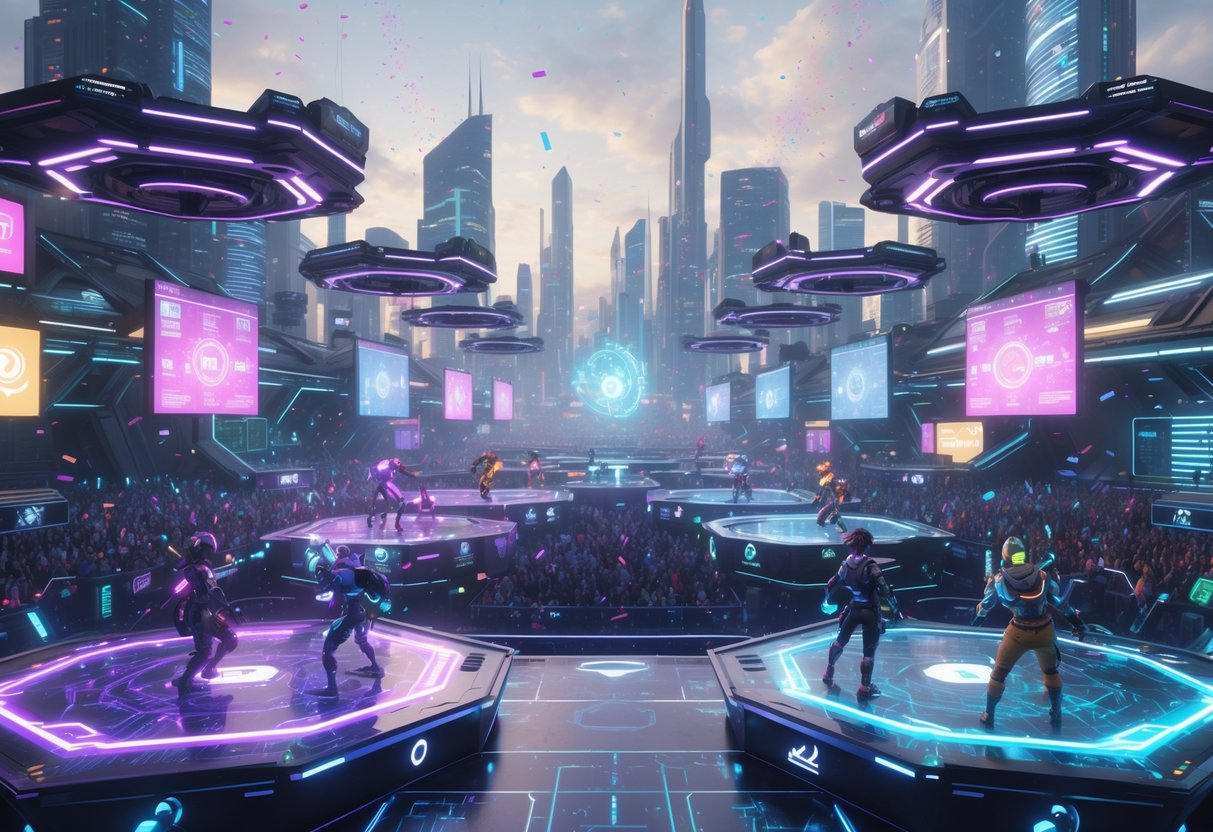
New technologies like AI and virtual reality are about to change how we experience competitive gaming. The next wave of esports will mix physical and virtual worlds in ways we haven’t really seen yet.
Upcoming Technological Innovations
Artificial intelligence will shake up tournament organisation and how players experience events. AI systems will build tournament brackets that adjust in real time based on player performance and what viewers want to see.
We’ll get AI-powered spectator modes that let viewers pick camera angles or follow their favourite players. These systems will spit out instant stats and analysis during matches.
Virtual reality will pull fans closer to the action. Instead of watching on a screen, spectators will sit in virtual stadiums with thousands of fans from around the world.
Augmented reality will layer game info and player stats right into our view. Imagine watching a tournament and seeing health bars or cooldowns floating above players’ heads.
Blockchain tech will lock in tournament results and pay out prizes automatically. Smart contracts will make sure players get their winnings right after matches, cutting out delays and arguments.
Trends Shaping the Next Generation of Esports
Tournament formats are moving away from old-school brackets to ongoing virtual worlds. Players will compete in campaigns that last weeks or months, not just a single day.
User-generated content is becoming a big deal. Communities will make their own tournament maps, game modes, and even new competitive formats inside metaverse platforms.
Cross-platform integration means tournaments won’t stick to just one game. We’ll see competitions where teams face off across different titles in the same virtual space.
Social features are getting a boost. Spectators will form virtual supporter groups, build fan zones inside venues, and chat with players before and after matches.
Revenue streams are multiplying with virtual merchandise and digital collectibles. Fans will buy team jerseys for their avatars or snap up limited-edition memorabilia that only exists in the metaverse.
Predictions for the Metaverse Tournament Ecosystem
The global virtual tournament market is on track for big growth. Platforms like Decentraland and The Sandbox should host major competitive events by 2026.
Traditional esports organisations will have to adapt or risk fading away. It looks like established tournament organisers will team up with metaverse platforms instead of trying to fight them.
Prize pools will go beyond cash. Winners might get virtual real estate, avatar upgrades, or governance tokens that let them vote on future tournament decisions.
Regional tournaments will matter less as geography loses its grip in virtual spaces. A player from Manchester can team up with someone in Tokyo—no travel or visas needed.
Hybrid events will probably become the norm, with some players competing on-site and others joining virtually. This setup keeps tournaments accessible and still brings the energy of live events.
Amateur players will finally get access to pro-level tournaments. Metaverse platforms will open up competitive gaming by knocking down old barriers.
Frequently Asked Questions
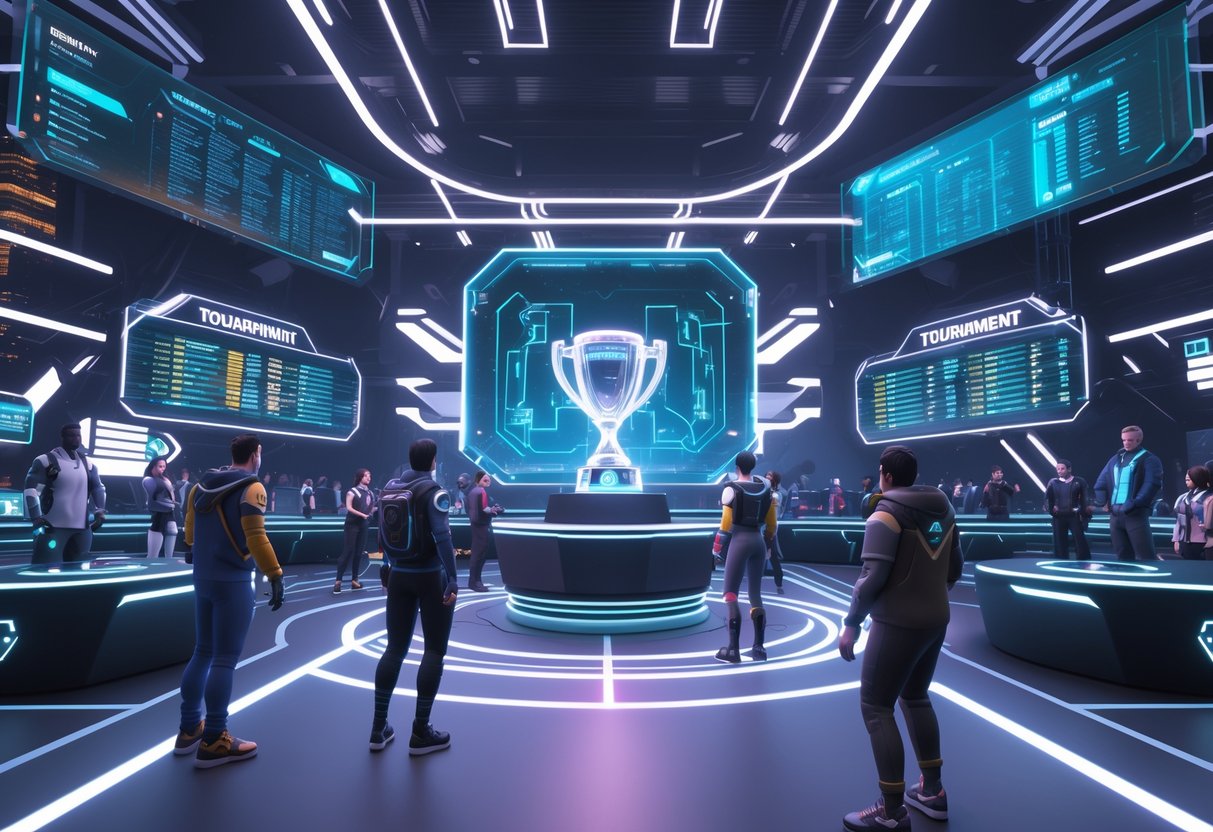
People have plenty of practical questions about joining virtual tournaments, what gear they need, and how they can earn money. These questions cover everything from age requirements to ticket buying and reward systems.
How can I participate in virtual reality cricket tournaments?
Most VR cricket tournaments ask you to register through platforms like Meta Horizon Worlds or specific cricket gaming apps. You’ll need to set up an account and watch for tournament announcements.
Many tournaments welcome beginners and experienced players alike. Registration usually opens a few weeks before the event.
You’ll find opportunities on gaming forums, social media, and official tournament sites. Some platforms have weekly matches, while others run seasonal championships.
What are the prerequisites for joining a Metaverse concert?
You’ll need a compatible device like a VR headset, gaming console, or smartphone, depending on the platform. Most concerts work with basic gear, but VR headsets give you the best experience.
Set up an account on the hosting platform first. Popular venues include VRChat, Horizon Worlds, and Roblox.
Test your internet speed, since streaming virtual concerts needs a good connection. Download any required apps or updates before the event.
Are there any age restrictions for attending Metaverse events on platforms like Roblox?
Roblox asks users to be at least 13 years old for certain features and events. Players under 13 have limited chat and social options.
Most metaverse platforms set similar age minimums, usually between 13 and 18. Some adult-only events require age verification.
Always check specific event rules before signing up. Tournament organisers often set their own age brackets to keep things fair.
What equipment do I need to fully enjoy an immersive Metaverse tournament experience?
A VR headset like Meta Quest 3 or PlayStation VR2 gives you the most immersive experience. Entry-level headsets start around £300.
You can still join with a regular gaming PC, console, or even a smartphone for many tournaments. Most platforms support several device types.
A solid internet connection is key—aim for at least 25 Mbps download speed. Gaming headphones also help with audio quality and team communication.
How can I purchase tickets for upcoming Metaverse events, including sports and music?
Many metaverse events are free, especially on platforms like Roblox and VRChat. Premium events usually sell tickets through the platform’s built-in store.
Look for official announcements in the platform’s news section or on social media. Tickets for big events tend to go on sale weeks in advance.
Some events take regular payment methods, while others use platform currencies or crypto. Double-check payment options before the sale begins.
Can I earn prizes or rewards by competing in Metaverse gaming competitions?
Absolutely, you can win prizes on many platforms, and the rewards can be anything from digital items to real money. I’ve seen some tournaments hand out prizes ranging from £20,000 all the way up to £1 million—that’s no small change.
In the blockchain gaming world, they usually pay out with NFTs or crypto tokens. If you stick to more traditional platforms, you might get in-game currency or maybe some exclusive items.
How much you actually earn? Well, that really depends on where you place in the tournament, how active you are, and the rewards system for that specific platform. Even if you don’t snag a top spot, a lot of these competitions still give out something just for showing up.

